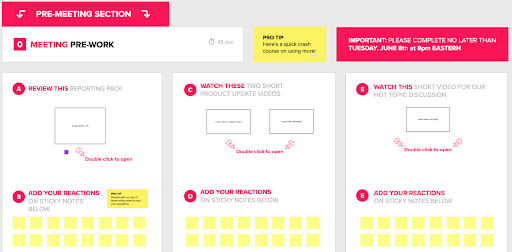Anyone who’s ever regularly attended board meetings will be familiar with the most common complaint about them: Board meetings are stressful and, well, boring. You sit and listen to presentations, sift through company reports and financial figures and occasionally take a vote. Meanwhile, these meetings can be intimidating since your Board of Directors are investors in the company — and have the ability to fire you.
You can find a lot of suggestions out there for how to make your board meetings more engaging. However, few of them actually address the fundamental problem — that is, board meetings are traditionally set up solely for the benefit of the board members. They’re built to pass information one-way. This means the onus is on the CEO and others to give updates (i.e. long monologues), present lots of data and provide whatever other information the board needs.
It’s no wonder board meetings get boring fast. But does it really have to be this way?
How to Hold Collaborative Board Meetings
The MURAL leadership team decided to flip the concept of a board meeting on its head. The purpose of a board meeting should be to create an opportunity to help the CEO run the company. What if we could transform these meetings from long, tedious information dumps to problem solving sessions and opportunities to attack the most critical blockers of your company? The result would be that our leadership team could make better decisions for the company.
Here’s what we did.
It’s All About the Prep
We quickly realized the key to getting board members to come to our meetings ready to interact was to give them the essential information beforehand. By encouraging board members to do their homework asynchronously, attendees could answer any basic questions beforehand. They would then be primed and ready to participate and dive into a useful discussion.
The obstacle to success? Getting people to do that homework.
The first step was to make the prep seem less intimidating. Trying to do everything at once would turn people off. So we chose a manageable number of meeting topics (in our case, it was two) and then focused on creating rich, engaging content around each. For each of these topics, we had leaders provide an overview from their perspective through a short and informative Loom video. For example, when we launched our Free Plan, our CMO Peter Herbert put together a Loom covering key metrics and outcomes from the launch. This primed everyone for our live discussion.
Alongside homework, we sent out reporting packs that covered all the metrics we use on a daily, weekly and quarterly basis. We make these metrics easy to digest by transferring them directly from our business intelligence tool into a deck, then pairing the metrics with some storytelling to give the board members the necessary context.
Once we gathered our content, we shared it using a mural (more on this in a bit) three days in advance of the meeting. We encouraged recipients to add questions to the mural in advance so everyone can see the questions ahead of time.
The end result? We were able to remove the slowest and most tedious portion of the board meeting — the “show and tell” — by delivering useful and engaging company updates to our board members in advance. This allowed us to use the time during our meeting more strategically. We engaged in discussion with our board members, extracted valuable feedback from them and built a better business.
Using MURAL to Promote Engagement
Now, we didn’t just want our board members to read and view the content we created—we wanted them to become active participants. That meant we had to do more than just send it to their inboxes and hope for the best. We had to make engagement fun.
And how else would we do this than to drink our own champagne? We made a mural.

If you’re not familiar, murals are digital canvases used to visualize ideas, share insights and collaborate with others. Using a mural, you can lay out a meeting in different areas — like a template — that provide structure. Everyone can access a mural on their own device using a shared link. That way, everyone can add ideas, notes, graphics, and more right on the mural together.
For this board meeting mural, our goal was to give the board meeting a clear framework, as well as make participation simple and entertaining. To do this, we broke our mural up into distinct sections. At the top was the prep work section with links to the reporting pack and videos we wanted our board members to watch. Below the prep work was our meeting agenda, along with sub-sections for different activities, such as CEO reflections and hot topics.
Finally, we included a section for reflecting on the meeting (we want to continue improving and feedback is critical!). Throughout, we left space for board members to add their thoughts, reactions, takeaways or whatever else they wanted to share.

The advantages of this approach were numerous. For instance, because everyone could see other board members creating sticky notes and adding in their own questions and ideas, everyone was encouraged to actively participate. One idea would spur another, and then another. No one wanted to be left out, and it was now easy for everyone to share.
Pro tip: If you encounter board members that are not very responsive or engaged, find one or two early adopters and ping them individually to get the ball rolling.
Using a mural also appealed to the different ways people absorb and react to content. Some can take in information instantly and immediately give their opinion. Others need more time to reflect in order to offer a well-thought-out suggestion. Unsurprisingly, traditional board meetings (and meetings in general) largely engage the loudest people in the room and discourage more introverted personalities from participating.
With our approach, we were able to make the process of engaging with content much more democratic. Some people were ready to give their input as soon as we sent them the mural. Others slowly, but steadily, contributed their suggestions in the days leading up to the meeting. In the end, we heard from everyone—whether through the mural or in the meeting. Insights that could easily be lost in a traditional structure became important discussion points. Better yet, there were no surprises in the actual board meeting because everyone had the information ahead of time.
Another pro tip: While this approach was tailored to a board meeting, using a mural to make the most of your team’s time, whether it’s the board, your leadership team or your weekly meetings, is how tens of thousands of teams are using MURAL today.
The Benefits of a Collaborative Board Meeting
Just as with every winning team, there’s always someone, a coach or some other facilitator, who guides everyone, improving the odds of success for the team. Board meetings (and most meetings) stand to benefit from these guides, as well. Everyone can benefit from structure — even senior executives. Collaborators benefit when a facilitator keeps the meeting focused, running on time, and ensures everyone contributes their ideas toward key initiatives.

Our approach allows us to turn every board meeting into what it should be: a collaborative experience for discussion, learning and decision-making to help leadership tackle the hardest problems and arrive at the strongest solutions. This approach maximizes our time together and our entire company benefits.
Sharing data before the meeting and using time together to problem solve is a different way to run a board meeting, and it’s a method that’s transformed how we operate at the highest level of our company.




